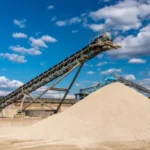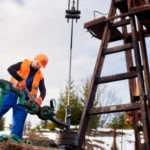What is Fracturing Fluid in the Hydraulic Fracturing Process
Our modern world relies heavily on oil and natural gas, much of it being trapped in tight rock formations. On the other hand, the energy demand is continually growing, thereby driving innovation in extraction techniques. Among these is hydraulic fracturing, commonly known as fracking, which has revolutionized the global energy landscape and become vital in the oil and gas industry. This blog dives deep into the composition and utility of fracturing fluid in modern energy production.
The complex hydraulic fracturing process allows for the extraction of resources from low-permeability rock formations. It relies heavily on a specially designed substance: fracturing fluid, a precisely formulated mixture engineered to maximize the extraction of hydrocarbons from low-porosity formations. From creating fractures to transporting proppants, its role is multifaceted. Read below to learn more!
Composition of Fracturing Fluid
Hydraulic fracturing fluids are a complex blend, meticulously designed to perform specific tasks to unlock resources trapped deep within the earth. Let’s explore what is fracking fluid composed of below.
1. Water: The Hydraulic Powerhouse
Water is the primary component, providing the necessary pressure to induce fractures. Its abundance and availability make it a practical base fluid. The immense pressure that the water provides is the initial key to the entire process. That is why water based fracturing fluids are used.
2. Proppants: The Fracture Stabilizers
Sand or ceramic particles, known as proppants, are critical for maintaining the integrity of the fractures. They prop open the cracks, creating pathways for hydrocarbons to flow to the surface. Without them, the fractures would close under the immense pressure of the rock.
3. Carrying Agents: The Delivery System
Whether it’s slickwater, gel or foam, these agents transport proppants deep into the formation. They ensure the proppants are evenly distributed and effectively lodged within the fractures. The selection of the carrying agent is dependent on the specific geological formations.
4. Chemical Additives: The Functional Enhancements
These additives are the secret ingredients that optimize the fracking process. They are added to make the process as efficient and safe as possible. They include friction reducers, corrosion inhibitors, biocides and other chemicals.
All in all, fracturing fluid is the dynamic force that transforms a sealed rock formation into a productive energy source.
Common Chemical Additives in Fracturing Fluid
The efficacy of fracturing fluid lies in its meticulously chosen compounds, each engineered to perform specific tasks within the complex underground environment.
1. Friction Reducers
These polymers minimize the friction between the fluid and the wellbore, allowing for higher pumping rates and reduced energy consumption.
2. Biocides
These prevent the growth of bacteria that can corrode pipes and clog formations, ensuring the well’s longevity.
3. Surfactants
These reduce the fluid’s surface tension, improving its ability to penetrate rock pores and enhancing hydrocarbon flow.
4. Scale Inhibitors
These prevent the formation of mineral deposits (scale) that can block pipes and reduce well productivity.
5. Clay Control Agents
These stabilize clay minerals in the formation, preventing them from swelling and obstructing flow paths.
6. Crosslinked Fluids
These more complex systems involve gelling agents, buffers and crosslinkers. They create a viscous fluid that effectively carries proppants into fractures, particularly in high-temperature or high-pressure environments.
Sunita USA stands as a pivotal partner for the oil and gas industry, delivering not just advanced oilfield chemical manufacturing and distribution, but comprehensive fracturing fluid component solutions. We have partnered with key oil and gas industry players, working closely to provide tailored solutions that address their specific hydraulic fracturing fluid needs.
Variations in Fracturing Fluid Composition
The composition of hydraulic fracturing fluids is far from static and depends on what fracking fluid is being used for. It’s a flexible formula, constantly adapted to the specific demands of the subsurface environment. The type of rock being fractured, the targeted resources (oil or gas) and characteristics of oil and gas wells all play pivotal roles in determining the fluid viscosity and composition.
In addition to the base fluids and proppants, companies use their unique mixture of fracking chemical additives. This leads to many proprietary blends, meaning each hydraulic operation can require a different fluid, thus calling for site-specific fracturing fluid engineering.
At Sunita USA, we recognize the complexities of modern hydraulic fracturing operations and offer a wide array of specialized components for fracturing fluid. We understand that each well presents unique challenges, which is why we collaborate closely with our clients to deliver customized formulations that meet their specific needs, ensuring responsible and effective operations.
The Role of Fracturing Fluid in the Hydraulic Fracturing Process
Hydraulic fracturing fluids are the essential agents that drive the process, directing it from initial wellbore preparation to final resource retrieval. Here’s a breakdown of the key steps involved in the process:
Step 1: Wellbore Drilling
While not directly involved in drilling, the composition of the fracturing fluid is designed with the wellbore’s characteristics in mind, anticipating the conditions it will encounter.
Step 2: Fracturing Fluid Injection
With calculated force, the engineered fluid is injected at extremely high pressure. This surge overcomes the inherent tensile strength of the target rock formation, initiating the critical hydraulic fracturing process.
Step 3: Creating Fractures
The fluid’s hydraulic force generates a network of fractures, expanding pathways for hydrocarbons to flow.
Step 4: Proppant Placement
The fluid acts as a delivery system, carrying proppants deep into the fractures to keep them open and sustain fluid flow.
Step 5: Fluid Recovery
After the fracturing stage, a portion of the fluid returns to the surface, allowing for resource extraction. The fluid’s composition influences how effectively this “flow back” occurs.
Safety and Environmental Regulations in Hydraulic Fracturing
The use of fracturing fluid has raised legitimate concerns regarding its potential impact on safety and the environment. These concerns primarily revolve around groundwater contamination, surface spills and the disposal of produced water. Recognizing these risks, stringent regulations have been implemented to mitigate potential hazards.
Government agencies, such as the Environmental Protection Agency (EPA) in the United States, establish and enforce regulations concerning fracking fluid disclosure and disposal. These regulations often mandate the public disclosure of fracking chemicals additives and set standards for the safe disposal of produced water, which can contain residual fracturing fluid and naturally occurring contaminants.
Organizations like the American Petroleum Institute (API) have developed guidelines for well construction, fluid handling and waste management. Continuous advancements in technology and monitoring further enhance the safety and environmental performance of hydraulic fracturing, striving to balance energy production with environmental stewardship.
Conclusion
Undeniably, fracturing fluid plays an indispensable role in modern hydrocarbon extraction with an undeniable contribution to energy industry with oil and gas production. Effective hydrocarbon extraction demands precisely engineered fracturing fluid solutions developed while being mindful of geological formations, target resources (oil or gas) and wellbore characteristics.
Founded in 2013, Sunita Hydrocolloids Inc., USA (SHI) is an innovative oil field chemical company providing a variety of quality stimulation chemicals such as guar-based gelled fracturing fluids, friction reducers, cross-linkers, corrosion inhibitors, clay stabilizers, defoamers, non-emulsifiers and breakers to the North and South American markets. Contact us for tailored solutions!





